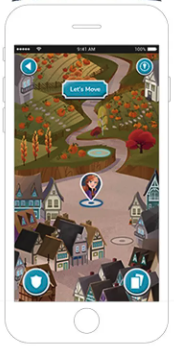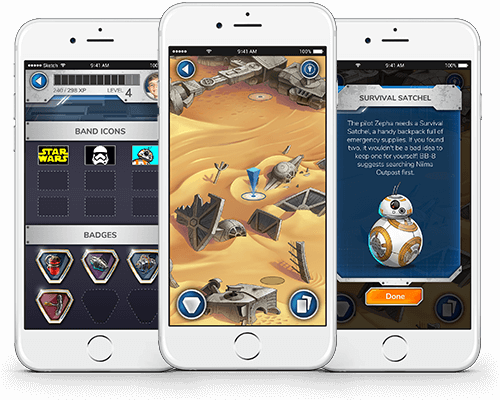As an elementary school teacher that has a passion for physical movement and physical literacy, I am interested in educational tools that encourage kids to move. Although the Garmin Jr. app wouldn’t currently be easily integrated into the classroom (due to the limitations of needing to own specific kid friendly Garmin watches), this is still a worthwhile app to add to the “Mobile Technologies” section of the Knowledge Mill, and a potential glimpse into future technologies that may become more readily available and accessible for elementary school classroom applications.
The Garmin Jr. App works with specific Garmin watches (Vivofit Jr. 2 & Vivofit Jr. 3), and acts as a central hub that connects kids smart watches to a user profile, which allows them to track steps, heart rate, chores and sleep, all while gamifying the experience. The app connects to a parents smartphone, and the majority of the child’s interaction is with the watch itself. This is great design feature, as it keeps the child’s experience connected directly to the watch and negates the need for the child to have a phone.
One of the most innovative aspects of the Garmin Jr. app is the way in which it gamify’s movement for kids. Watches can connect to various themes (including Marvel, Disney princesses, Star Wars, Frozen, etc.), and from the watches, kids are then able to play theme based mini games that integrate movement, chat with their parents/guardians, and collect tokens to be used to upgrade various aspects of their watch (new screen colours/background pictures etc.).

Of course there is the glaringly obvious downside of any app that can only be used with an external product (can’t use it if you don’t own it), but even-so, a potential future in which gamified movement apps are polished to the same degree as Garmin Jr. is certainly an exciting one.

This is really interesting to me, for a few reasons. As Jamie mentioned this would have limited use in the classroom due to the cost and the need for individualized technology, but I agree that it is an interesting, provocative concept related to wearable mobile technology.
I am primarily concerned with Elementary-age students, who are often at an age where they have arrived at a sort of crossroads when it comes to physical activity. The days of “all-in” participation in gym glass are giving way to more of a cynicism and a desire to either specialize in a sport, or migrate away from physical activity altogether. The classroom environment has become more sedentary, screen time is increasing, and body image and other issues have come in to play.
The question of how to motivate students to get active in meaningful ways is challenging and even controversial. In my recent work helping develop a new Health curriculum for Grade 6 learners in my province, experts informed us that any incentivization of physical activity has to be meaningful and contextualized for students. Framing it as a punishment, or something that will gain an external reward or specific outcome for one’s body, lends itself to unhealthy concepts of self-worth, body image, and the value of exercise as something we all can and should do in ways we enjoy.
That’s why I’m interested by Garmin Jr. I personally use a Garmin smartwatch to monitor my own physical activity, because I enjoy being able to track my activity over time, share my activities with others in my running club or community, and “gamify” physical activity when it feels boring or onerous. I like the idea is uses a similar strategy to games like Prodigy, to turn the physical activity into a game that is unrelated to the task at hand. Physical activity isn’t meant to be done “just because”, and there isn’t a direct relationship between the amount of activity and student success; students get to decide how they value the feedback they get from the device.
I think that wearables for younger kids are a slippery slope, but this review and my own examination of Garmin Jr. suggests to me that perhaps they are on the right track, and this could be useful in certain situations.
I use apps for tracking my exercise and how many steps I use each day. However, I have been looking for one that is geared towards kids. This looks like a great a very great app for them because it has that focus on themes that kids like, like Dinsey Princesses and superheroes, and it has games that encourage exercise. I will look into Garmin Jr. more and see if it it is available in my region.
Hi Jamie, this is really neat. I like the fact that the watch enables “hands-free” device use. Something about not being glued to it the same way a cell phone requires makes it seem less intrusive, and as you said means they don’t have to have a phone. Tracking chores sounds like something I could/should personally use with my kids! Anything that helps engourage a healthly lifestyle and promotes movement is good thing, there also may be some medical reasons where heart rate etc. are needed to be tracked in children.
I agree, it is neat that students can use the watch independent of a phone. Also, I hadn’t thought about the potential medical benefits or assistance that this type of technology could potentially lead to. I hope that this wearable, health-driven technology for kids (and adults actually) continues to blossom. I would also be interested in learning more about whether or not there have been any school based trials for these watches. I know that there has been student based research around pedometers and heart rate monitors, but I would guess that the benefits of adding gamification to those technologies (as Garmin is currently doing) could be quite beneficial.